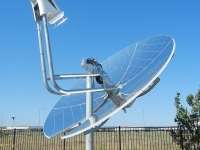The Department of Energy's laboratory is developing a new technology that can transform natural gas power stations into hybrid solar power plants.
The device, which is being developed by the Northwest Pacific National Laboratory (PNNL), is about four feet tall and two feet wide, containing a chemical reactor and several heat exchangers. Through the narrow channel of the reactor containing the catalyst, the concentrated light can heat the natural gas stream, which helps to convert natural gas into syngas, a higher energy fuel.
The solar concentrator will generate steam at 700C to produce a methane steam reforming reaction that will increase the efficiency of natural gas power stations by 20% to 25%.
Bob Wegeng, head of the Northwest Pacific National Laboratory project, said: “We are increasing the natural gas fuel content by about 25%, thus producing the same amount of electricity and requiring less natural gas. The resulting carbon dioxide is reduced by about 20%, and the required methane is needed. Also reduced by 20%."

The device is being developed by the Pacific Northwest National Laboratory and is about four feet long, two feet wide, containing a chemical reactor and several heat exchangers
Wegeng said that so far, the device has been used in the solar power sector in the southwestern United States, but it can also be applied to the chemical industry. Syngas can also be used to make synthetic crude oil, which can be refined into transportation fuels.
His team aims to achieve a six-cent SunShot per kWh plan by 2020, which will allow hybrid solar natural gas power plants to compete with conventional fossil-fuel power plants while also reducing greenhouse gas emissions. A 500 MW power station will require about 3,000 parabolic mirrors equipped with PNNL equipment.
However, Wegeng said that the technology can be commercialized in just three years.
He said: "Our challenge is to build a reaction system that is cheap enough. When they are mass-produced, you will really find out about its economic advantages. We are now competing to see how quickly we can commercialize this device." We are working hard to increase the efficiency of our components while driving mass production."
This summer, PNNL will conduct field trials at the campus in Richland, Washington. Earlier prototype tests showed that more than 60% of the solar energy incident on the system's parabolic mirror was converted to chemical energy in the syngas.
Currently, the project received about 4.3 million U.S. dollars from Solar Thermo Chemical LLC, the Department of Energy's SunShot program and industry partner, Santa Maria, California. SolarThermoChemcial holds a cooperative research and development agreement for the project and plans to manufacture and sell the system after the project ends.
Single Curtain Bracket,Metal Curtain Wall Bracket,Decorative Curtain Rod Bracket
Bochuang Hardware Co., Ltd. , http://www.hz-curtain-rod.com